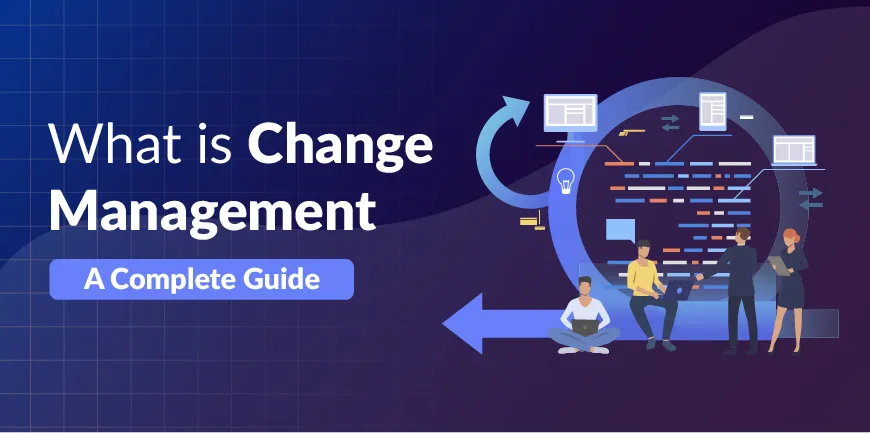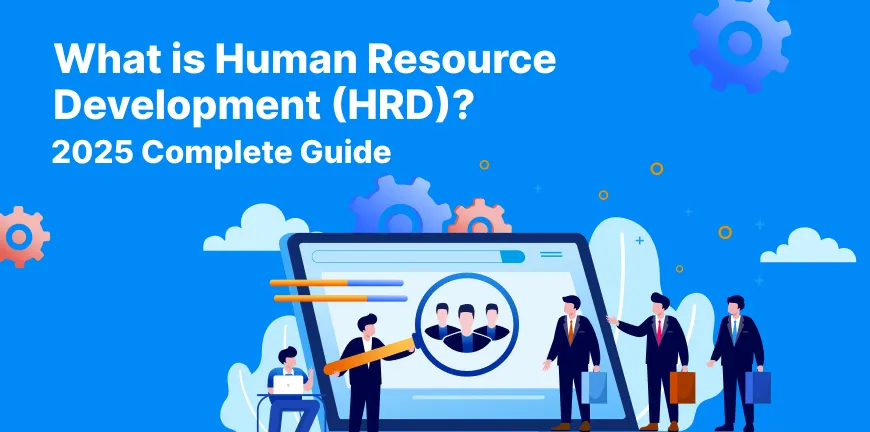
Engineer Recruitment Process in Japan: A Guide for Foreigners
27/10/2025
What are Appraisal Letters? Meaning & Definition
27/10/2025- What is Change Management? Meaning & Definition
- Why Change Management Matters in 2025
- 7 Types of Change Management You Should Know
- Core Principles of Effective Change Management
- 5 Key Benefits of Implementing Change Management Strategies
- 5 Major Challenges and Risks in Change Management
- 6 Best Practices for Successful Change Implementation
- Popular Change Management Models and Frameworks
- Real-World Success Stories: Change Management That Delivers Results
- Future Trends in Change Management
- Building Change-Ready Organizations for 2025 Success
- Key Takeaways
- FAQs
Transformation failure is a persistent problem, with 70% of all initiatives falling short due to “people issues.”2 However, effective change management provides a systematic solution. Companies applying a structured approach are seven times more likely to achieve strategic objectives and realize up to 143% of expected ROI.
This discipline, which moves individuals and teams from current to desired future states, drives measurable improvements in efficiency and profitability.
This change management guide explores the definition, benefits, principles, and proven strategies of change management to help organizations build the resilient, adaptable operations necessary for sustained success in 2025 and beyond.
What is Change Management? Meaning & Definition
Change management in HRM represents a systematic approach to guiding organizational transitions across goals, processes, and technologies. This structured framework supports strategic implementation while helping individuals adapt to new operating environments. The discipline has matured substantially over the past quarter-century, becoming essential as businesses navigate constant, complex, and high-stakes operational shifts.
Effective organizational change management extends far beyond announcing upcoming modifications to staff. The approach encompasses comprehensive strategies for employee preparation and support, detailed implementation planning, and continuous monitoring throughout transition periods. Moreover, organizations use this systematic methodology to minimize operational disruption while maintaining productivity.
Successful change management addresses four fundamental requirements:
- Analyze the impact on existing processes, systems, and workforce capabilities.
- Establish structured planning, testing, implementation, and evaluation phases.
- Document procedures to enable rollback capabilities when necessary.
- Maintain compliance with internal policies and external regulatory requirements.
Organizations that skip structured planning often watch well-intentioned initiatives lose momentum. Change cannot simply be mandated from leadership: people require support through transitions with clear communication, appropriate training, ongoing assistance, and feedback mechanisms to prevent confusion, resistance, and implementation failure.
Leadership and change management scope varies dramatically, from individual department projects to enterprise-wide digital transformation initiatives introducing multiple new processes and applications. Modern change management must integrate with daily workflow rather than relying solely on static plans and training materials.
Organizational change typically follows two distinct paths. Incremental change involves gradual product, process, or strategy improvements that develop over time. Additionally, transformational change represents fundamental shifts affecting organizational mission, structure, or strategic direction.
The discipline encompasses different organizational perspectives. Organizational Change Management (OCM) examines company-wide requirements, while change management often focuses specifically on individual and team adaptation during transitions. This comprehensive approach draws from behavioral sciences, social sciences, information technology, and business operations.
A critical distinction separates basic change communication from comprehensive change management. Many organizations limit efforts to simple communications announcing upcoming changes. True change management supports individual transitions from current to future states, understanding what motivates each person to embrace and adopt new approaches. This people-centered methodology significantly improves project success rates while ensuring organizational investments deliver meaningful returns.
Change management has evolved into a recognized academic discipline, with universities establishing dedicated research centers focused on organizational transformation. This recognition reflects the importance of change management in helping organizations succeed amid the constantly shifting modern business environment.
Why Change Management Matters in 2025
The business environment of 2025 presents unique challenges that make structured change approaches essential for organizational survival. Change has shifted from periodic disruption to a constant operational reality. Executive leadership acknowledges this shift—85% report that change management projects have increased significantly in recent years. Meanwhile, 73% of HR professionals observe their employees experiencing change fatigue, creating a complex dynamic that requires careful navigation.
The post-pandemic era accelerated digital transformation across industries, driven by the Fourth Industrial Revolution and substantial technological shifts following the COVID-19 crisis. Organizations face persistent challenges with 60% to 70% of change initiatives failing, making effective change management approaches more critical than traditional project management alone.
Change management models directly influence organizational performance outcomes. Companies implementing formal change management strategies are six times more likely to meet objectives and 3.5 times more likely to stay within budget. This connection between structured change approaches and business results makes change management expertise a competitive necessity rather than an optional capability.
Modern workplaces require rapid adjustments to maintain market position. Structured change management frameworks help organizations:
- Identify potential risks and develop mitigation strategies.
- Drive employee engagement and adoption of new initiatives.
- Enhance organizational agility and adaptability.
- Effectively leverage technology and innovation.
- Increase employee productivity and improve decision-making.
An effective change management strategy produces measurable business benefits, including improved decision-making by managers, reduced conflicts, fewer operational errors, enhanced organizational performance, and increased employee motivation. These outcomes become particularly valuable as organizations prepare for continued uncertainty.
Change agility represents a fundamental business capability, enabling organizations to prepare for transitions by recognizing change as inevitable. Additionally, organizations now invest in specialized training for leaders in change management and resilience, helping them adapt to challenging situations and reframe obstacles as growth opportunities.
Human-centered approaches have gained prominence as organizations prioritize employees’ emotional and psychological needs during transitions. Soft skills like empathy and emotional intelligence have become essential qualifications for change leaders. Agile change management methodologies that favor iterative, continuous improvements over large-scale transformations allow quicker adaptation to market shifts and employee feedback.
Organizations that connect change management to performance outcomes and understand which elements most significantly affect results can prepare for emergencies while saving time and resources. This preparation reduces risks associated with sudden changes and ensures a competitive advantage through continuous improvement processes embedded in organizational culture. Change management represents an essential business imperative for organizations operating in the complex environment of 2025.
7 Types of Change Management You Should Know
Organizations typically experience five major firmwide changes every three years, with nearly 75% expecting to multiply the types of major change initiatives in the next three years. Understanding different types of change management becomes essential for navigating these transitions effectively, especially considering that half of change initiatives fail.
1. Planned Change
Planned change occurs when organizations identify specific needs and develop systematic implementation processes. This deliberate approach involves management outlining detailed roadmaps for smooth transitions with clear objectives. Businesses implement planned changes through long-term strategic planning focused on future objectives or short-term planning addressing immediate operational needs.
2. Unplanned Change
Unplanned changes emerge spontaneously in response to unexpected external events like economic shifts, natural disasters, or sudden market fluctuations. Often called remedial or reactionary change, this approach requires quick adaptation and flexible response mechanisms. Moreover, organizations experience unplanned change through emergencies demanding immediate reactions or unexpected opportunities requiring swift action.
3. Transformational Change
Transformational change represents fundamental overhauls of organizational systems, processes, or culture, completely restructuring that creates entirely new operational models. This radical process may alter company direction, vision, or mission, requiring strong leadership and a willingness to challenge established norms. Transformational changes often involve strategic revamps with fresh visions or significant leadership transitions.
4. Incremental Change
Incremental change involves small, continuous adjustments made over time without altering core company structures. This gradual approach allows organizations to adapt with lower risk than radical methods. These adaptive changes address daily, weekly, and monthly business challenges through improvements like adding new payment options, implementing intake forms, or upgrading software versions.
5. Strategic Change
Strategic change entails significant alterations aligning with the organization’s long-term goals. This approach involves modifying company objectives, mission, or vision to adapt to market or industry shifts. Strategic change requires alignment across different organizational levels. Moreover, organizations implement strategic changes to realign goals with new market conditions or completely rebrand their business positioning.
6. Structural Change
Structural change focuses on reorganizing physical or hierarchical layouts within organizations. This includes altering reporting lines, merging or dividing departments, or changing management levels. Additionally, structural changes impact information flow and often require significant adjustments to roles and responsibilities. These changes commonly occur during mergers and acquisitions, market expansions, or regulatory updates.
7. Technological Change
Technological change involves implementing new technologies or updating existing systems, affecting product production, service delivery, or internal communication. These initiatives require comprehensive retraining, upskilling, and ongoing employee support. A hospital transitioning to electronic health records exemplifies technological change, requiring structured implementation phases to ensure widespread adoption.
Organizations should select appropriate change management models based on their specific change type. The Lewin Model works effectively for structural changes through its three clear stages. The ADKAR Model suits technological changes by focusing on individual readiness. Kotter’s 8-Step Model supports transformational changes through its emphasis on building organizational buy-in.
Understanding these change management types enables organizations to select the most appropriate strategies, ultimately increasing successful implementation in environments where change has become constant.
Core Principles of Effective Change Management
Successful organizational transformation requires systematic approaches that address both strategic objectives and people-centered implementation. Organizations following structured change management methodologies achieve 59% higher effectiveness levels than those using informal approaches. These eleven fundamental principles create the foundation for business-first change solutions:
1. Planning
Planning establishes the cornerstone for any meaningful transformation initiative. Leaders must develop detailed implementation strategies outlining when, how, and why changes occur before presenting proposals to their teams. This preparation ensures clarity and direction throughout transition periods, preventing the confusion that derails many well-intentioned initiatives.
2. Transparency
Transparency builds essential trust between leadership and workforce, even when confidential aspects limit full disclosure. Sharing available information helps employees feel more comfortable with upcoming transitions. Honesty complements transparency by maintaining credibility, particularly when communicating challenging circumstances or potential negative outcomes.
3. Communication
Communication serves as the backbone of organizational change management. Maintaining open dialogue between leadership and employees creates opportunities to explain rationales while remaining receptive to questions and concerns. Effective communication pairs with clear roadmaps that help staff understand organizational trajectory—past achievements, current position, and future direction.
4. Training
Training becomes essential when changes involve new technologies or processes. Providing adequate skill development opportunities ensures employees feel supported rather than overwhelmed by unfamiliar requirements. This systematic approach works alongside participation principles, where involving employees in decision-making processes generates valuable perspectives while creating ownership of outcomes.
5. Patience
Successful change management requires patience through gradual implementation rather than overnight transformations. Strategic rollout allows for natural adaptation and adjustment periods. Throughout implementation, leaders must monitor and measure progress through consistent oversight, defining success metrics, and addressing issues promptly.
6. Strong leadership
Strong leadership connects these principles into cohesive action plans. Leaders must inspire teams, demonstrate strategic thinking, maintain flexibility, and show genuine concern for employee well-being. Research confirms the correlation between sponsor effectiveness and meeting change objectives, with 79% of projects featuring highly effective sponsors achieving their goals.
Understanding that organizational change requires individual change remains crucial for sustainable transformation. Large-scale initiatives ultimately depend on individual employees adopting new behaviors, using updated tools, and complying with revised policies. Organizations implementing these systematic principles are seven times more likely to exceed their objectives, demonstrating how structured change management approaches create remarkable business opportunities from potential disruption.
5 Key Benefits of Implementing Change Management Strategies
Organizations that embrace structured change management strategies gain substantial business advantages that extend far beyond smooth transitions. Research validates the measurable value these systematic approaches deliver to organizational performance.
The impact of quality change management becomes clear when examining project success rates. Organizations moving from “poor” to “fair” change management increase their likelihood of meeting objectives threefold. These results highlight how proper implementation strategies directly affect business outcomes and return on investment.
1. Enhanced Business Performance Through Operational Excellence
Effective change management drives improved business performance through streamlined processes and optimized resource allocation. Your organization can identify redundant tasks and operational bottlenecks, creating measurable improvements in productivity and profitability. When you define success metrics clearly for change initiatives and measure performance against objectives, your odds of meeting or exceeding those objectives can increase by up to five times.
2. Stronger Employee Engagement and Ownership
A structured change management process creates deeper employee engagement throughout your organization. When your team understands the strategic reasoning behind changes and sees their direct impact, they become invested partners in successful outcomes. This approach builds a culture of active participation, giving employees genuine ownership that translates to increased motivation and job satisfaction.
3. Reduced Risk and Enhanced Organizational Stability
Change management provides essential risk mitigation capabilities for your business. Unmanaged changes frequently result in costly delays, budget overruns, or incomplete implementations. Systematic change management reduces these risks by identifying potential challenges early and establishing contingency plans, protecting your resources while strengthening organizational stability.
4. Improved Communication and Decision-Making
Clear change management processes ensure consistent information flow throughout your organization. This transparency eliminates the confusion and misinformation that occurs when teams receive conflicting or incomplete details. Your teams can make better-informed decisions and maintain focus on high-priority activities that drive business results.
5. Greater Organizational Agility and Competitive Advantage
Change management strengthens your organization’s ability to respond effectively to market shifts and internal adjustments. Companies with robust change processes can pivot quickly when opportunities arise, enabling them to seize competitive advantages while mitigating potential risks in challenging market conditions.
Research from Prosci demonstrates that organizations prioritizing change management consistently achieve stronger outcomes, with 88% of participants with excellent change management meeting or exceeding objectives. Change-ready organizations position themselves for sustained growth, better resource utilization, and a culture of innovation that creates lasting competitive advantages in their markets.
5 Major Challenges and Risks in Change Management
Well-planned change initiatives still encounter significant obstacles during implementation. Successfully managing organizational transitions presents ongoing challenges for business leaders. Understanding these potential roadblocks allows organizations to develop proactive strategies that address complex transitions before problems emerge.
1. Resistance to Change
Resistance represents the most common reason change initiatives stall. This opposition typically occurs when stakeholders do not understand the changes being implemented or their business benefits. Employees often resist because they feel comfortable with existing systems and question the need for new approaches. Warning signs include workarounds, negative feedback in team communications, training absences, and minimal adoption of new features.
2. Leadership Roadblocks
Inadequate executive support creates fundamental barriers to successful change management. Many executives lack understanding of their role in change initiatives, required resources, or the strategic purpose behind the changes. This gap leads to inconsistent communication and reduced visibility throughout the organization. Research demonstrates a direct correlation between sponsor effectiveness and project success rates.
3. Communication Challenges
Communication breakdowns create significant risks during organizational change management. Without transparent, goal-aligned communication strategies, confusion affects groups impacted by the changes. Leaders often communicate extensively before launching initiatives, but fail to maintain consistent messaging throughout implementation. Poor communication generates rumors and uncertainty, which increases employee resistance.
4. Cultural Barriers
Change initiatives that conflict with established corporate culture face reduced success rates. When employees respond with “That’s not how we operate,” it signals that your change management strategy contradicts organizational culture. Organizations with histories of failed changes, departmental silos, and resistant behaviors experience lower performance and engagement levels. Addressing cultural misalignment requires systematic approaches to shifting employee mindsets.
5. Implementation Challenges
Poorly defined change management processes create confusion and inefficiencies during execution. Common implementation obstacles include:
- Starting with incomplete strategies focused on what changes without adequate attention to implementation methods.
- Following rigid plans that cannot adapt to unexpected developments.
- Setting unrealistic expectations that push too aggressively for immediate results.
- Extended implementation timelines that cause fatigue and increased costs.
These challenges demonstrate why change management requires systematic planning, stakeholder engagement, and realistic implementation schedules. Organizations that prepare for these common obstacles significantly improve their transformation success rates.
6 Best Practices for Successful Change Implementation
Successful implementation represents the foundation of any effective change management initiative. Research shows organizations that utilize formal change management strategies are six times more likely to meet objectives and 3.5 times more likely to stay within budget. The following best practices provide a clear roadmap for organizations managing complex transitions.
1. Thorough planning
Thorough planning must occur before any team announcements. Effective leaders develop detailed change management plans covering when, how, and why changes are occurring. This preparation should document necessary tasks, outline change management roles and responsibilities, establish realistic timelines, and anticipate potential concerns.
2. Transparency
Transparency builds trust throughout the process. Even when certain aspects must remain confidential, sharing available information helps employees feel more comfortable with upcoming transitions. Honesty creates credibility—even when communicating challenging circumstances or potential negative outcomes.
3. Effective communication
Effective communication forms the backbone of successful organizational change management. Keeping communication channels open between leadership and employees allows for explanation of rationales behind changes while remaining receptive to questions. Leaders should:
- Take time to explain why changes are happening.
- Hold team meetings to address concerns.
- Create opportunities for one-on-one discussions.
- Maintain consistent messaging across all channels.
4. Creating a Robust Roadmap
Creating a clear roadmap helps employees understand where the organization has been, where it currently stands, and its future direction. This context demonstrates the strategic thinking behind the change and helps staff see how it fits into the business model they’ve grown accustomed to.
Proper training becomes essential when changes involve new technologies or processes. Organizations should provide adequate skill development opportunities and communicate that training will be available when announcing changes. This proactive approach prevents employees from feeling left behind due to a lack of skill or experience.
Participation represents another valuable practice. Giving employees opportunities to contribute feedback or participate in decisions fosters ownership while providing perspectives that leadership might not have considered. Understanding that change takes time prevents rushed implementation—longer, strategic rollouts allow for adjustment periods and natural adoption.
Strong leadership remains fundamental throughout the process. Leaders must inspire their teams, demonstrate strategic thinking, maintain flexibility, and show genuine concern for employee well-being. A strong leader guides their team through even the most challenging transitions with confidence and a clear vision.
Popular Change Management Models and Frameworks
The right change management tools and framework selection determines success for organizations undertaking transformation initiatives. Research shows that transformations utilizing appropriate models achieve nearly eight times higher success rates when they focus on four key actions rather than relying on just one.
Lewin’s Change Management Model provides a systematic three-phase approach: Unfreeze (preparing the organization), Change (implementing the transformation), and Refreeze (solidifying the change in company culture). This straightforward model works well for structural modifications, though it oversimplifies complex changes and lacks detailed implementation structure.
The McKinsey 7-S Framework evaluates seven interconnected organizational elements divided into “hard” components (Strategy, Structure, Systems) and “soft” components (Shared Values, Skills, Style, Staff). This analytical framework helps align various organizational aspects, but requires a more comprehensive methodology to become fully actionable.
Organizations needing step-by-step guidance find Kotter’s 8-Step Process delivers a clear roadmap: Create urgency, build a guiding coalition, form strategic vision, enlist volunteers, enable action, generate short-term wins, sustain acceleration, and Institute change. This top-down model supports major transformations effectively yet may overlook informal leaders within the organization.
ADKAR Model focuses on individual change through five sequential building blocks: Awareness, Desire, Knowledge, Ability, and Reinforcement. This people-centered approach proves valuable when individual behaviors determine project success, particularly for adopting new technologies or processes.
Prosci Methodology incorporates the ADKAR Model within a structured three-phase process, supported by the Prosci Change Triangle. Built on 25 years of research, this methodology treats change as an ongoing process rather than a single event.
Additional frameworks include the Bridges Transition Model, which addresses emotional journeys through three phases (Ending/Losing/Letting Go, Neutral Zone, New Beginning); the Kübler-Ross Change Curve mapping emotional responses (Denial, Anger, Bargaining, Depression, Acceptance); and the Influence Model emphasizing four key actions: fostering understanding, reinforcing changes through formal mechanisms, developing talent, and role modeling.
The ideal model depends on your organization’s specific requirements and change context. Many practitioners combine elements from different frameworks to create tailored approaches addressing both individual and organizational aspects of transformation.
Real-World Success Stories: Change Management That Delivers Results
Organizations across diverse industries demonstrate how structured change management approaches deliver measurable business outcomes. These proven success stories and change management examples highlight practical applications that transform theoretical principles into tangible results.
A global aerospace organization confronted significant user adoption challenges after implementing an ERP system due to technical complexity and standardized processes. Their change management experts conducted stakeholder interviews, identified internal barriers, and developed targeted recommendations before proceeding with system upgrades. This systematic approach resolved adoption issues and ensured successful implementation.
A leading food and beverage company addressed substantial learning curves when replacing legacy systems through structured change management strategies. Their comprehensive approach included detailed communication plans, change champion training, and consistent project branding, resulting in markedly improved employee engagement.
The retail sector provides another compelling example where a major global retailer integrated change management into its SAP implementation. This thoughtful methodology achieved higher user adoption rates, delivered significant cost savings, and earned the company SAP’s Retail Implementation of the Year award.
HMRC (Her Majesty’s Revenue and Customs) modernized complex government processes through leadership development, employee engagement initiatives, and strategic technology integration. Their structured approach delivered measurable improvements in both customer service quality and employee satisfaction.
Adobe transformed HR functions by replacing annual performance reviews with continuous “check-in” methods, emphasizing targeted hiring practices, and creating human-centric workplace approaches. These changes increased employee retention substantially while building an innovation-focused culture.
Barclays Bank executed a dramatic strategic shift under CEO Antony Jenkins, moving from high-risk investment banking toward customer-focused operations following the 2008 crisis. This transformation generated an 8% share price increase and achieved £1.7 billion in cost reductions during 2014.
Coca-Cola adapted to changing consumer preferences by expanding product portfolios to include healthier options while implementing sustainability initiatives. Their systematic approach improved operational efficiency and strengthened brand perception simultaneously.
Financial services company Aktia strengthened existing cultural strengths—customer collaboration, innovation, courage, and accountability—enabling them to embrace external changes by building upon established internal capabilities.
These success stories validate how organizations investing in professional change management approaches achieve superior results across industries and transformation types. Each example demonstrates the practical value of systematic, well-executed change strategies.
Future Trends in Change Management
Change management practices continue evolving as organizations face increasingly complex business challenges. Several key trends are reshaping how companies approach organizational transitions, creating new opportunities for competitive advantage.
Artificial intelligence integration now enables real-time sentiment analysis, adaptive communication strategies, and data-driven decision-making to improve adoption rates. Machine learning algorithms analyze employee behavior patterns and predict resistance points before they emerge, allowing change managers to proactively address concerns. Intelligent chatbots and virtual assistants provide 24/7 support to employees navigating transitions.
Agile change methodologies are replacing traditional linear approaches. This shift recognizes that change in modern organizations requires continuous adaptation rather than one-time events. Agile change management emphasizes rapid prototyping of initiatives, frequent feedback loops, and the ability to pivot quickly when market conditions shift.
Personalization has become central to effective organizational change management. Advanced analytics platforms create detailed profiles of how individual employees respond to different types of change, enabling personalized change journeys that maximize engagement.
The post-pandemic business environment has accelerated the adoption of digital-first change experiences. Virtual and augmented reality technologies now play significant roles in change training, providing immersive experiences that help employees visualize new ways of working.
Organizations are developing change-agile cultures by upskilling their leaders with specialized training in change management and resilience. This investment enables leaders to adapt to difficult situations and reframe obstacles as opportunities for growth.
The future of change management balances technological sophistication with human-centered approaches. Technology provides unprecedented capabilities for understanding and executing change, yet people remain at the heart of successful transformation. Organizations that embrace both technological innovation and human-centered design principles position themselves to navigate the ever-shifting landscape of modern business.
Building Change-Ready Organizations for 2025 Success
Change management serves as a strategic business solution for organizations navigating today’s complex operational environment. Our analysis demonstrates how structured approaches to organizational transitions create measurable competitive advantages. Companies implementing formal change management practices achieve their strategic objectives more consistently while protecting resources and timelines.
Understanding different change types, from planned and incremental adjustments to transformational and technological shifts, enables organizations to select appropriate strategies for specific business contexts. Core principles, including thorough planning, transparent communication, gradual rollouts, and strong leadership, provide the foundation for successful transitions that support both individual adaptation and organizational growth.
Business performance improvements emerge directly from effective change management through streamlined operations, enhanced workforce engagement, proactive risk mitigation, clear communication protocols, and strengthened operational agility. Organizations face predictable implementation challenges, including resistance patterns, leadership alignment issues, communication breakdowns, cultural conflicts, and execution difficulties.
Success requires adopting proven practices that emphasize systematic planning, honest stakeholder communication, comprehensive training programs, employee participation opportunities, and realistic implementation schedules. Framework selection—whether using Lewin’s three-phase model, Kotter’s 8-Step Process, or the individual-focused ADKAR approach- should align with specific organizational requirements rather than generic solutions.
Industry success stories across aerospace, retail, banking, and technology sectors validate how structured change management approaches deliver measurable returns on investment. These examples highlight the importance of balancing technological capabilities with people-centered implementation strategies.
Future change management capabilities continue advancing through artificial intelligence integration, agile methodologies, personalized employee experiences, digital-first training programs, and change-agile cultural development. Technology provides unprecedented analytical and execution capabilities, yet successful transformations ultimately depend on supporting people through transitions from current to future operational states.
Whether you are a startup scaling operation, an established organization maintaining talent pipelines, or a company seeking to outsource change management functions, structured approaches create sustainable competitive advantages. Organizations that invest in systematic change management capabilities position themselves as industry leaders capable of turning operational challenges into growth opportunities.
Alp Consulting helps organizations build change-ready operations through business-first solutions that support both immediate transition needs and long-term adaptability requirements.
Key Takeaways
- Success Multiplier: Structured change management increases initiative success rates 7X, meeting objectives and staying on budget.
- Dual Focus: Successful change requires addressing both organizational systems and supporting individuals through communication and training.
- Tailored Strategy: Seven distinct types of change demand specialized frameworks; strategies must be tailored for optimal results.
- Core Methodology: Effective change relies on clear principles: comprehensive planning, transparency, consistent communication, and gradual implementation.
- Future Approach: Trends blend AI technology for data insights with human-centered approaches for personalized, agile change experiences.
FAQs
1. What are the core principles of change management?
Change management principles include thorough planning, transparent communication, gradual implementation, and strong leadership. These principles help organizations navigate transitions effectively by ensuring stakeholder involvement, clear roadmaps, and adequate support throughout the change process.
2. How does change management benefit organizations?
Change management offers numerous benefits, including improved business performance, enhanced employee engagement, effective risk mitigation, better communication, and increased organizational agility.
3. What defines successful change management?
Successful change management involves a structured approach to transitioning individuals, teams, and organizations from their current state to a desired future state. It encompasses strategies for preparing and supporting employees, establishing implementation steps, and monitoring activities to ensure successful outcomes.
4. What are the key components of effective change management?
The key components of effective change management include clear communication, stakeholder engagement, leadership support, training and development, and continuous monitoring and adjustment.
5. How is change management evolving for the future?
Change management is evolving to incorporate artificial intelligence, agile methodologies, personalized approaches, and digital-first experiences. Future trends emphasize building change-agile cultures and balancing technological innovation with human-centered design principles to navigate the ever-shifting business landscape.




